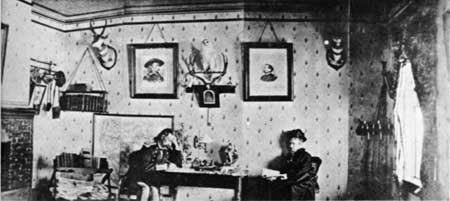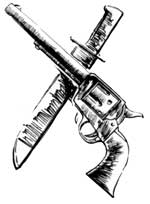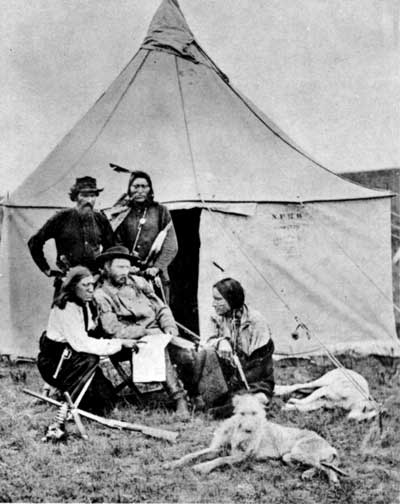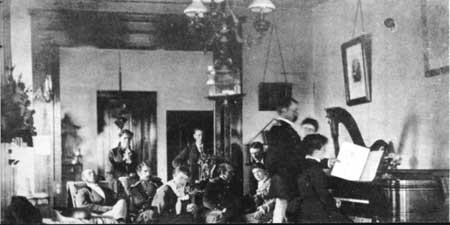|
LITTLE BIGHORN BATTLEFIELD National Monument |
 |

General and Mrs. Custer in their library at Fort Lincoln. This
photograph was taken about 1875.
Gen. George Armstrong Custer
The Custer Battlefield has been named after Brevet Major General Custer, the commander of the Seventh Cavalry, who, with more than 225 of his troopers, lost his life on this battlefield.
Custer was born in New Rumley, Harrison County, Ohio, December 5, 1839, the son of Emanuel and Maria Ward Fitzpatrick Custer. He spent much of his early life with his half sister, Lydia Reed, at her home in Monroe, Mich., where he attended school. At the age of 15 he met Elizabeth Bacon. Less than 10 years after their first meeting Elizabeth Bacon and George A. Custer were married.
In June 1857, Custer entered the United States Military Academy, West Point, N. Y. His many boyish pranks and escapades won him demerits that brought his rating near the bottom of his class. Following his graduation in June 1861, he was commissioned a second lieutenant in the Second United Stares Cavalry.

War had broken out between the States, and Custer joined his regiment in time to take part with his troop at the First Battle of Manassas. He was little more than 21 years of age, but there was an indefinable something about his vivacious personality that attracted the attention of his superiors. His conspicuous courage and zeal brought him many coveted honors and rewards.
During the war he was several times breveted for gallant and meritorious services at the battles of Gettysburg, Yellow Tavern, Winchester, and Fisher's Hill. His final brevet was that of major general, for outstanding services during the campaign ending in the surrender of the Confederate Army of Northern Virginia. He had been commissioned a brigadier general at the age of 23 and only 2 years later became a major general of the Union Army. Official records of the War Department show that Custer is the youngest brigadier general and major general in the history of the United States Army. With his rapid promotions, came both friends and enemies. Among his most loyal followers were those of the Michigan Cavalry Brigade, whom he had led at the Battle of Gettysburg. The following year, when Custer was transferred to command of the Third Cavalry Division, many Michigan men sought, through petition, to join Custer in his new command. At Appomattox, he was designated to receive the flag of truce from the Confederate Army of Northern Virginia. Later, in presenting Mrs. Custer with the table on which the terms of General Lee's surrender had been signed, General Sheridan said ". . . there is scarcely an individual in our service who has contributed more to bring about this desirable result than your very gallant husband."
After the Union Army was disbanded in 1866, the regular army was increased by several regiments. General Custer was assigned to the new Seventh Cavalry as its lieutenant colonel, and the regiment then took the field against hostile Indian bands that were raiding and pillaging white settlements in Kansas, Nebraska, and the Indian Territory. His victory at the Battle of the Washita, November 27, 1868, over Black Kettle's band of Cheyenne Indians, augmented with other Kiowa and Comanche tribes, was effective in discouraging further Indian depredations.

Custer and his scouts on the Yellowstone
Expedition of 1873. Bloody Knife, Custer's favorite scout, is
seated on Custer's right. He was killed with Reno's battalion just
before they retreated from the valley, June 25, 1876.
The winter of 1872, the Grand Duke Alexis of Russia came to the United States on a good-will tour. In plans for the official welcome, Custer was chosen to escort him about the West and to participate in a buffalo hunt. The Duke was delighted not only with the hunt but with Custer, whom he saw for the first time in the picturesque buckskin hunting attire which he always wore on the plains.
Custer was a man of diversified interests. When military duties did not demand his attention, he spent his time reading, writing, hunting, and mounting the trophies of the chase, or participating in social affairs with his wife and friends. His published writings and the publicity given his activities made him a beau ideal among Indian fighters. Although in the shaping of western history he found himself pitted against the Indians, he was not unaware of their problems. In My Life on the Plains (1874), he wrote, "If I were an Indian, I often think that I would greatly prefer to cast my lot among those of my people who adhered to the free open plains, rather than submit to the confined limits of a reservation there to be the recipient of the blessed benefits of civilization with its vices thrown in without stint or measure.

A social evening at the Custer home in Fort Lincoln. General Custer
stands beside Mrs. Custer who is seated at the piano. Tom Custer is the
first man in the rear and to General Custer's left, "Autie" Reed,
Custer's nephew, is standing in the doorway, and Boston Custer is
seated on the extreme left. This photograph was taken about
1874.
The Seventh Cavalry's record under General Custer well illustrates the important part played by the United States Army in the advance of frontier settlements. Stationed at remote army posts and isolated cantonments, they were called on to guard emigrants and freighters, mail stages, and telegraph lines. Sometimes they undertook exploring expeditions into little known regions, and sometimes they protected scientific expeditions into new territory. They shielded surveyors laying out the route for railroads, and the construction crews who built the roads. Sometimes they evicted white trespassers from Indian reservations, and sometimes they risked their lives in campaigns against the Indians.

|
|
Last Modified: Sat, Sep 28 2002 10:00:00 pm PDT |


